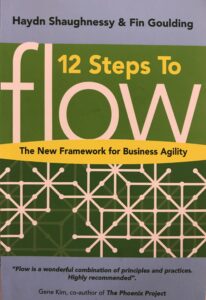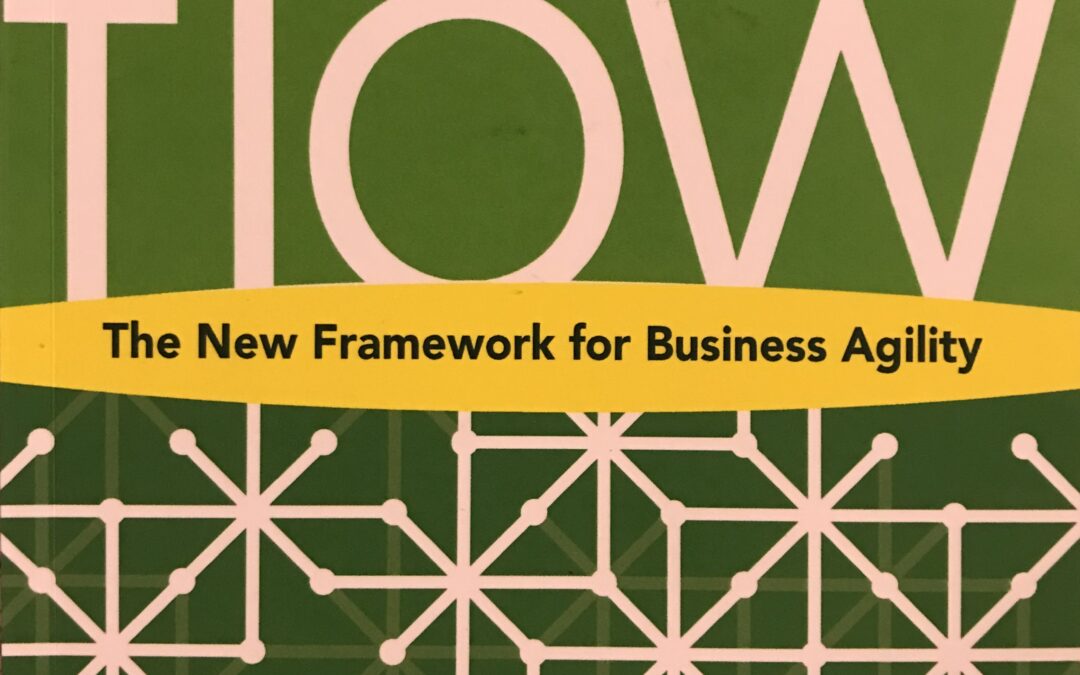Podcast: Play in new window | Download
Subscribe: RSS
This podcast is the first in a series reviewing the Introduction and Chapter 1 of “12 Steps to Flow: The New Framework for  Business Agility,” by Haydn Shaughnessy and Fin Goulding. They are the developers of the internationally acclaimed workshop, Flow Academy, which they will be presenting at the Business Agility Conference Midwest in Columbus, OH, Nov 4-5, 2019. The work centers on the importance of emotions and relationships in order to be customer-centric and create value.
Business Agility,” by Haydn Shaughnessy and Fin Goulding. They are the developers of the internationally acclaimed workshop, Flow Academy, which they will be presenting at the Business Agility Conference Midwest in Columbus, OH, Nov 4-5, 2019. The work centers on the importance of emotions and relationships in order to be customer-centric and create value.
INTRODUCTION: The Value-Seeking Enterprise
Their humanistic approach is consistent with Center for Managing Changes approach to moving the client into a more productive, valuable space.
Emotional honesty is key to developing relationships by team members to risk being vulnerable and working together proactively.
Senior management must be willing to delegate budgetary- and decision-making power down to the team level for success to occur in solving the customer’s problem.
The concepts of Matrix Innovation, Critical Non-Essentials, and Marginal Gains are introduced for:
- Enhancing products and services in parallel with determining emerging customer needs (Matrix Innovation), and;
- And increasing the team’s ability to add value quickly through apparently-ancillary activities that actually contribute to the team increasing their ability to add value quickly, e.g., team members having balance in relationships outside the team (Critical Non-Essentials), and;
- Management and team member working to do the little things that show fellow team members individual commitment, adding up, over time, to increased team performance
- This is important when looking at “long-tailed” portions of the market when new aspects of the market emerge but there are few clients, initially, in that area.
With value-seeking behaviors employees are encouraged to seek value at every turn, in every segment, in every task-breakdown and at every reflection point. The team must deal with multiple system changes to match the opportunity changes emerging in the economy. The behavior of selecting the best way to transform and match internal capabilities with systemic changes in the market becomes key. Behaviors replace processes.
A new cadence of work is introduced — the Flow Value Stack — which promotes value-seeking behavior. The Stack comprises:
- Segmentation and customer success analysis
- Agile Portfolios
- Flexible business goals
- Continuous value hypotheses
- Disrupting the cadence of work
- Customer Feedback Walls
- Flow value optimization reviews
Takeaways the reader should have after reading this book:
- Able to design new ways to work
- Knowing how to become truly agile across the whole business
- Being comfortable with fewer rules and set structures
- Creating real customer-centricity
- Creating a value-seeking culture
- Growing emotional resilience to support work in uncertainty
- Being able to advocate a more effective approach to strategy
Chapter 1: Talking About Business Agility – Using Flow Circles to Get You Started
“The aim is to create a dialogue so people get to define the change the are experiencing.”
Basic Flow principles are introduced:
- Visualize all work processes on walls
- Work processes are designed by people doing the work
- Work is always designed around goals
- Break work down into units of 1-2 days allowing for frequent discussions
- Use methods that are customer-centric with customer concerns driving innovation
- Be driven by the idea of value and customer success
Complexity theory is brought in by Gary with regards to being robust vs resilient. Robust teams simply do more of what they already know. Resilient teams focus on shifting their structure and behavior to adapt to changing situations and new information.
Prerequisites are defined to set up a Flow movement:
- Understand Flow first, a way to create social interaction around value and promote value-based behavior
- Clarify goals visually and iteratively — this is where a Post-It Wall comes into play
- Be transparent and be open with each other
- Be empowered
- Link Flow to new initiatives
- Invite people with different skill sets
- Invite people in digital transformation roles
- Keep the C-Suite informed
- Address the whole business
Setting the scene for Flow requires a commitment to:
- Raising only professional issues
- The meeting has equal share of voice — everyone is equal and gets to speak
- Empathetic leadership – support everyone feeling included
- Drive towards techniques that support Flow
- Have everyone say why they are there
The chapter concludes with some key exercises which include:
- Create a short visual document that says how you can work differently
- Create a Goals Wall for a Flow Circle
- Re-segment your customer base without analytics: make it a conversation
- Invite people from across the business to talk
Access the conference web site directly for any comments or questions, https://businessagilitymidwest.com/, or you can contact me at
https://www.ctrchg.com/contact/
In line with Business Agility and dealing with complex situations, you can download my free e-book MINDSET – 5 SIMPLE WAYS TO LOOK AT COMPLEX PROBLEMS and learn how to find a simple vantage point from which you can resolve challenges.
Your feedback is important. Choose from the following options:
- place a review in iTunes,
- click on “leave a comment” below,
- send any comments along with your name and the show number to support@ctrchg.com or
- call us at 614-226-1333 and leave a message including your name, the podcast number and podcast title.
Listen to future episodes for our reply.



Recent Comments